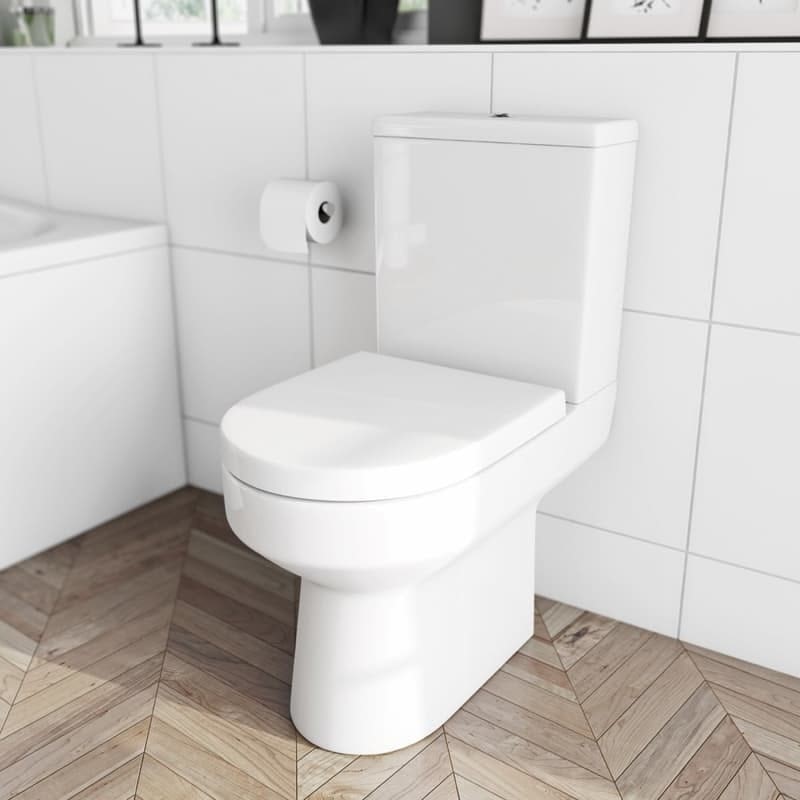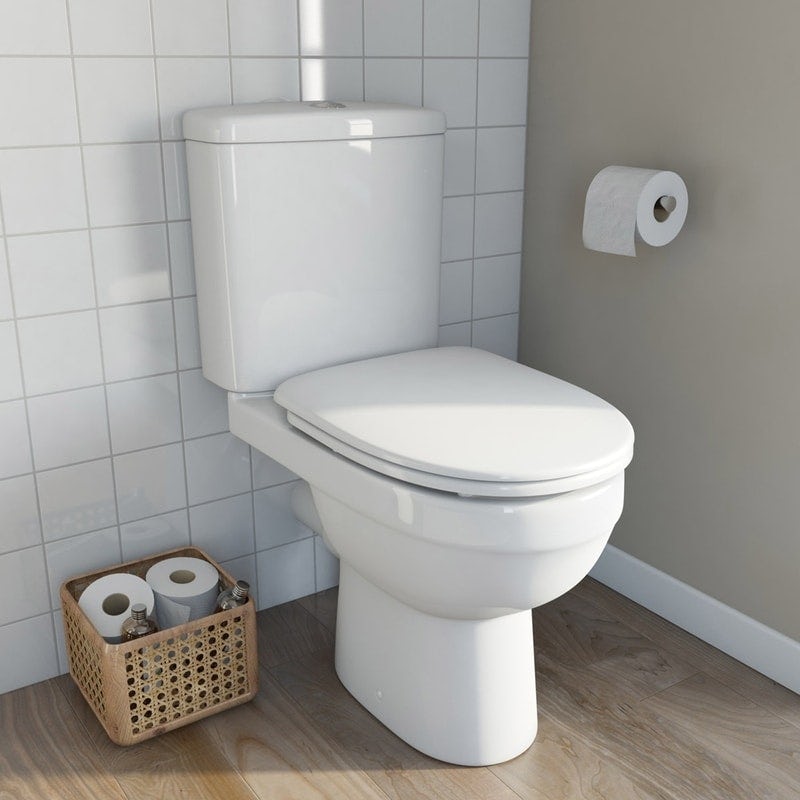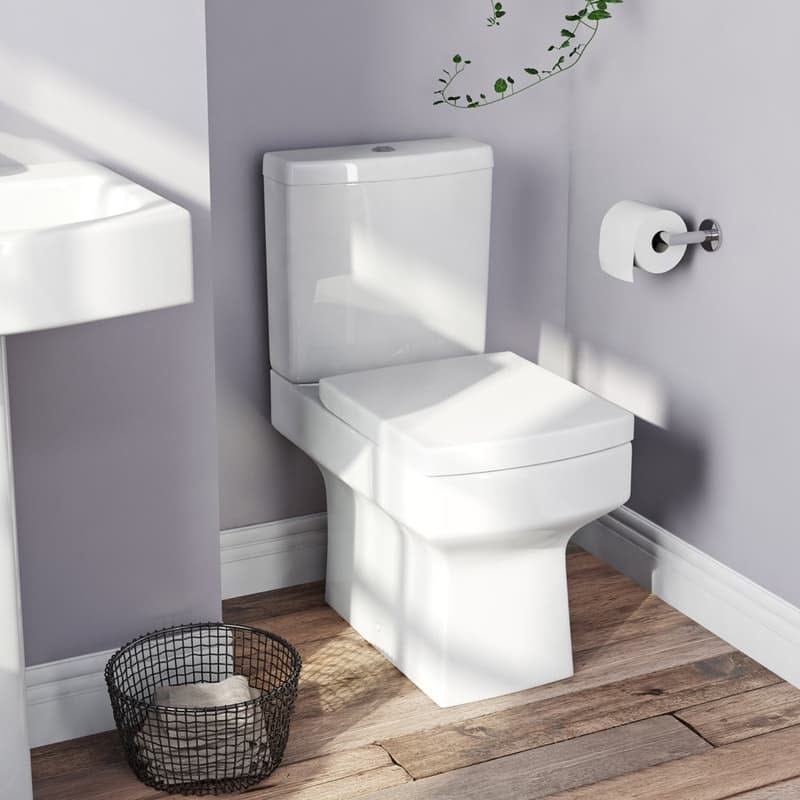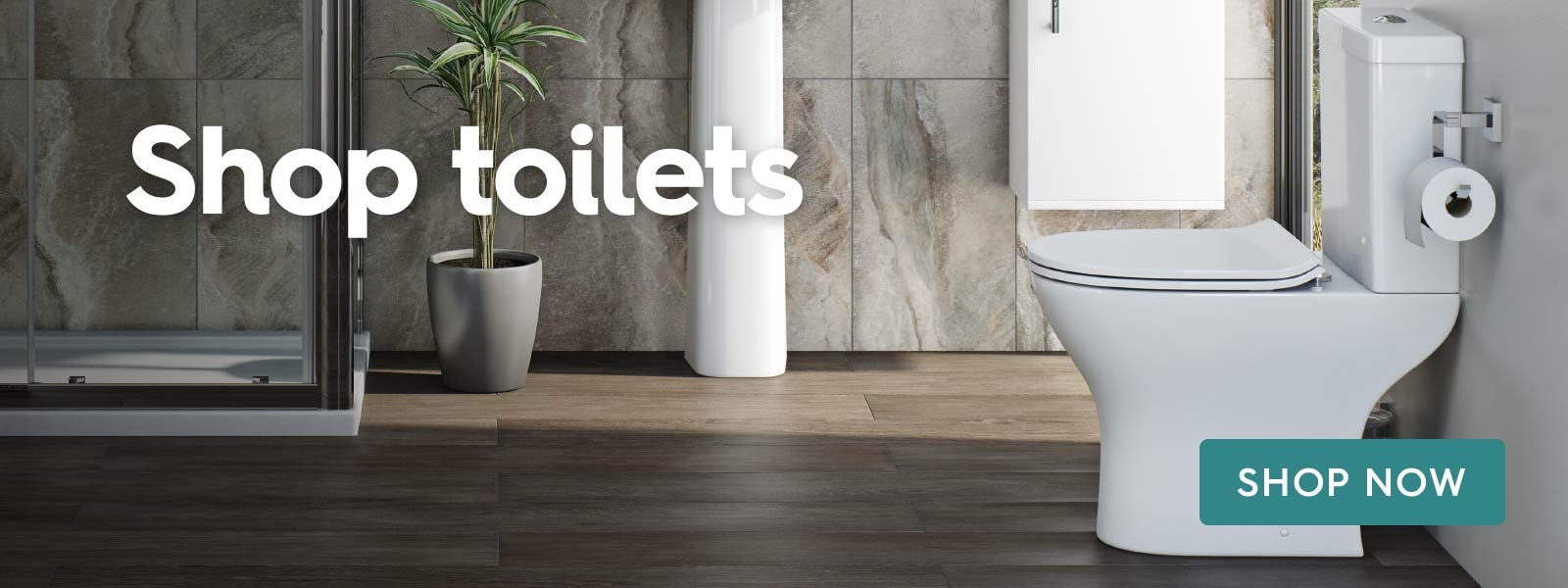Does a blocked toilet fill you with dread? In this handy article, we'll show you how to achieve your own Little Bathroom Victories, with some top tips on how to unclog that troublesome toilet and get it back into working order.
A blocked toilet can happen at any time and must be dealt with as soon as you notice a problem. Tell-tale signs usually include slow drainage or rising levels of water after flushing. You shouldn’t have to call on a professional plumber to fix the problem as it can usually be unblocked by following a few simple steps. Here are some tips on how to unclog a toilet.
Click on any of the links below to jump to a relevant section.
- How a toilet works
- Why do toilets get blocked?
- How to prevent toilet blockages
- How to identify the type of blockage
- Unblocking a toilet with a plunger
- Unblocking a toilet with hot water
- Unblocking a toilet with a toilet auger or plumbing snake
- Unblocking a toilet with water pressure
- Unblocking a toilet with baking soda
- Unblocking a toilet FAQs
- More bathroom troubleshooting guides and fixes
- Shop toilets
How a toilet works
An important part of knowing how to unblock a toilet at home comes from understanding how it works. A toilet works through a combination of 6 vital components:
- Water supply
- Cistern
- Flushing mechanism
- Toilet bowl or pan
- Waste outlet
- Toilet seat and lid
When the user flushes the toilet, the water naturally flows into the bowl, removing the waste. The waste outlet can either be built in a horizontal or vertical position, depending on the layout of the property. A siphon will also be installed to ensure the bathroom is not filled with waste-related odours.
Why not find out how a toilet is made?
Why do toilets get blocked?
There can be any number of reasons why you may experience a clogged toilet. Non-flushable items like those listed below can often be the cause:
- Cotton wool buds or balls
- Wet wipes (even those that state they are flushable)
- Sanitary towels
- Too much toilet paper
- Limescale build-up
- General waste
In most cases blockages can be avoided by ensuring the above does not happen. There are occasions where wider issues with the main sewer line cause a blockage which would require a specialist to investigate the problem more closely.
How to prevent blockages
By following some basic rules in and around the toilet you can reduce the likelihood of it becoming blocked. Aside from monitoring the type of objects that are disposed down the toilet, you should keep the lid closed whenever it is not in use. Not only do some experts believe it is more hygienic, there is less chance of anything falling into the bowl, especially if you have bathroom shelves positioned above.
- Avoid putting wet wipes, sanitary towels, too much toilet or other thick items into the toilet.
- Use bleach on a weekly basis to clean the inside of the bowel to prevent a build-up of limescale. Follow the instructions on the product to achieve best results.
How to identify the type of blockage
You don’t have to wait until the toilet is fully blocked to take action. There are a number of signs that will indicate if a clogged toilet is about to occur, so you can try to prevent it from happening. The 3 main signs include:
1. Slow drainage of water
After flushing, if the water drains from the bowl more slowly than normal then it is highly likely the toilet is in the early stages of a blockage.
2. Empty bowl after flushing
If the resting water does not return to the bottom of the bowl after flushing it could mean the waste pipes are experiencing an air circulation problem.
3. Rising water
A clogged toilet can also cause the water level to rise in the bowl. When this happens, it means there is a complete blockage that needs to be fixed.
If you notice any of the above occurring with your toilet, you should take immediate action. The longer the problem is left unresolved, the bigger the problem (and more expensive) it can become to fix.
Should you notice slow drainage of water, flush the toilet one more time before trying anything else. Only do this if there is a normal or low amount of water and not if there are higher levels than normal. If flushing the toilet doesn’t help, you can use a specially formulated chemical product or toilet unblocker that may be able to clear the blockage.
Toilets that are connected to a septic tank or cesspit, instead of a sewer, might experience a clogged toilet due to it being full. The best option here is to hire a professional engineer to visit your home to empty it out.
Unblocking a toilet with a plunger
Using a plunger is one of the most effective methods used for unblocking a toilet as it can unclog a wide variety of waste pipes. Anyone unsure how to unblock a toilet at home should first use a plunger:
- Use the rubber end of the plunger to cover the outlet at the bottom of the bowl. Make sure it is completely covered to block water and air from coming in. If the plunger is too small, use some old cloths or rags to plug the holes.
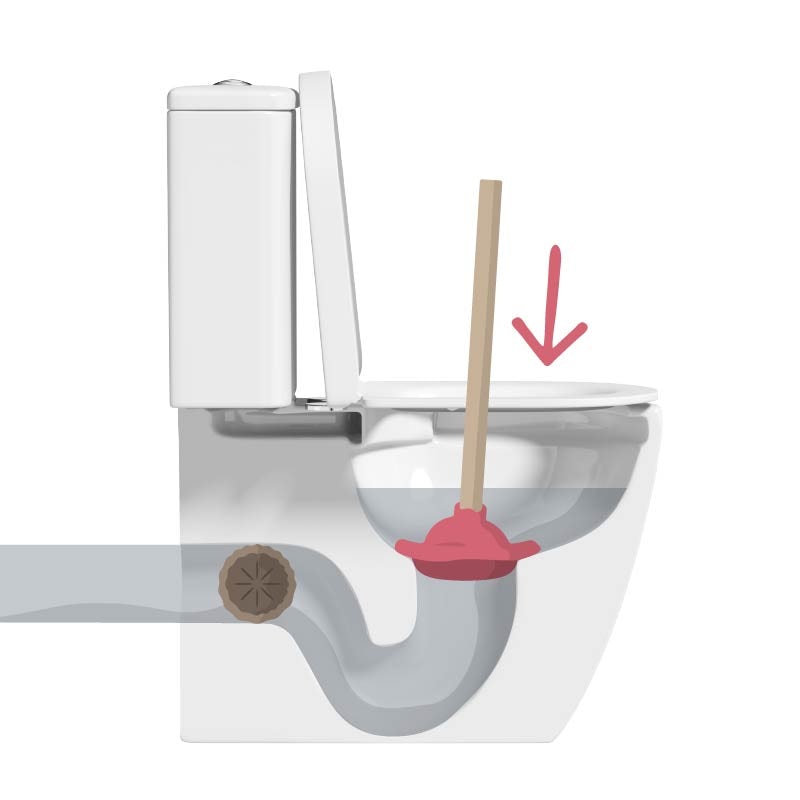
- Push down gently onto the plunger before slowly releasing. Do this repeatedly, gradually increasing the amount of force being applied onto the plunger. The water in the bowl should start to lower and you can refill using tap water. Return to using the plunger before flushing the toilet to see if it has removed the blockage.
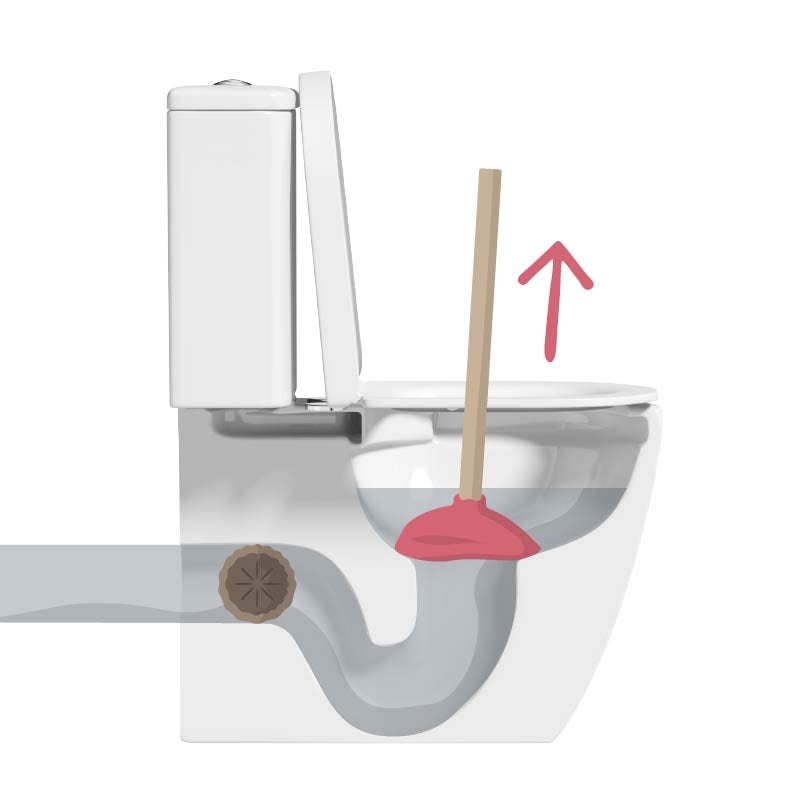

Unblocking a toilet using hot water
A partially clogged toilet can sometimes be cleared just by using hot water. The pressure produced by the hot water helps to push material blockages away, while the heat works to dissolve any fat or grease that may also have built up.
Before you begin, be sure to check that the water level is low. If not, remove water from the bowl to reduce the level.
-
Stop the cistern from refilling by closing the water valve. Depending on the toilet model, this is located on either side of the cistern or underneath.
-
The next step involves removing resting water from the bowl. Use rubber or disposable gloves so you do not get any onto your hands. Place the water into a bucket and dispose down an external drain instead of a household sink.
-
Squirt about half a cup full of washing up liquid into the bowl as this will provide lubrication. Leave it to settle for at least 10 minutes before proceeding to the next step.
-
Do not pour boiling water into the bowl, but instead, 2-3 litres of hot water. This will help build pressure onto the blockage. Pour the water in quickly and take care not to splash yourself.
Within a few minutes, the water level may start to drop. If not, and there is enough space inside the bowl to accommodate more water, you can repeat these 4 steps again. Try a plunger as your next step if this does not prove to be successful.
Unblocking a toilet with a toilet auger (or plumbing snake)
A toilet auger (also commonly known as a plumbing snake) is a toilet unblocker tool that is pushed into the toilet to clear the blockage in the waste pipe. The plumbing snake may be able to puncture a hole in the blockage, allowing water to pass through, pull the blockage out using the tip of tool or even destroy it completely.
- Take the plumbing snake (toilet unblocker tool) and push the corked-screw tip into the toilet until it reaches the item creating the blockage.
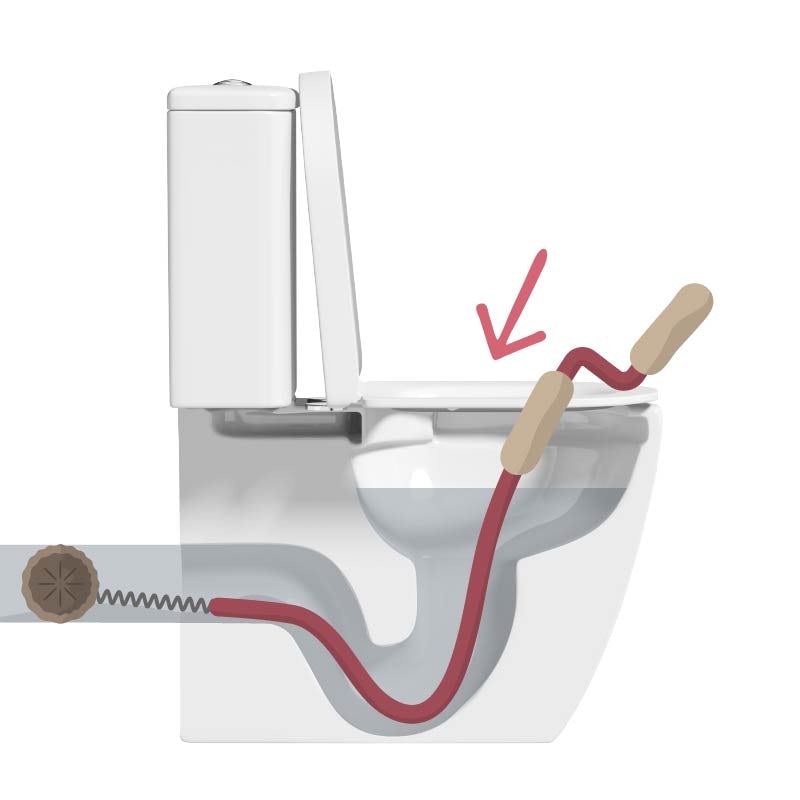
- Rotate and push down onto the plumbing snake so it comes into firm contact with the item. This will hopefully break the blockage down into smaller pieces so it can be flushed away.
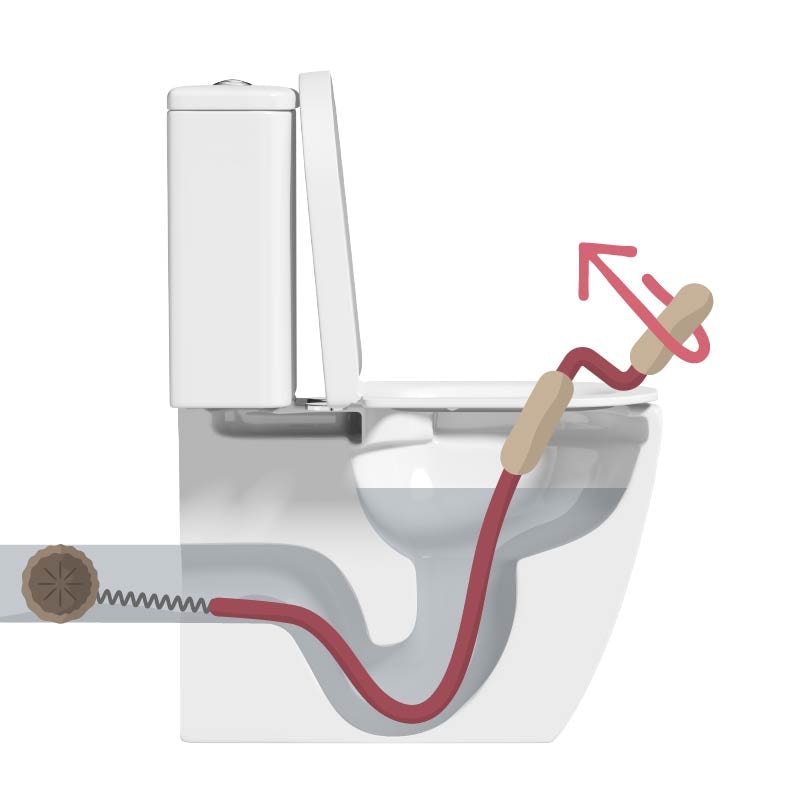
- The plumbing snake may pierce the item so it can be extracted from the waste pipe via the toilet bowl.

- Once the item(s) are removed, flush the toilet to ensure the system is back in good working order. Solid items that are stuck in the waste pipe may require the bowl to be removed so it can be accessed properly.
Unblocking a toilet with water pressure
If the above methods haven’t worked, you may be wondering how to unblock a toilet at home. Using water pressure can be a very effective option for blockages that cannot be reached by a plumbing snake. Even when the toilet isn’t totally blocked, water pressure is an ideal toilet unblocker tool that provides good maintenance.
Before using the water pressure method, ensure you have the right hose and nozzle equipment needed to perform the job safely and correctly. Toilets connected to septic tanks or cesspits should not use this option and instead hire a professional, as using this method could cause further damage.
-
Push the pressure hose nozzle first into the bowl.
-
Turn on the water pressure and let the hose be propelled deeper into the pipe by the water jet.
- The water jet will break up the blockage to clear it away from the waste pipe.
Unblocking a toilet with baking soda
Thanks to its natural properties, baking soda is often using with white vinegar as an effective cleaning tool in kitchens and bathrooms (as mentioned in our home cleaning hacks) to remove stubborn limescale. It can also be used as a toilet unblocker, to clear away blockages in the toilet.
With toilets that are connected to septic tanks or cesspits, you should hire a professional to clear the blockage as this method could cause more damage to the system.
-
Bring 2 to 3 litres of water slowly to the boil using a saucepan.
-
Before the water boils, add in half a cup of white vinegar.
-
Pour half a cup of baking soda into the toilet.
- Pour the water and vinegar toilet unblocker mixture into the toilet before closing the lid. The water and vinegar and baking soda will interact with each other to create a foam substance in the toilet. After 30 minutes return to the toilet and flush to see if the blockage has been cleared.
Frequently asked questions about unblocking a toilet
What is the best way to unblock a toilet?
There are many ways, as mentioned above, to unblock your toilet, but using a plunger is one of the most effective and the easiest way to remove a blockage in your toilet.
How do I unblock my toilet without a plunger?
If you have a blocked toilet but don't have a plunger there are many methods you can try before you need to call in a professional. The baking soda method is a great way to unblock your toilet and most of the items needed can be found in your home.
Will a toilet eventually unclog itself?
It may unblock itself, however, only part of the blockage may have been removed, allowing water to drain. This may lead you think the issue is resolved, when in fact it's building up and could cause more issues in the long run. We would always recommend you unblock your toilet otherwise you may have to call in a professional to sort and that will cost you a lot more.
How do you unblock a toilet full of poo?
If your blocked toilet is full of poo and toilet paper then you can use any of the above methods to remove the blockage. We would recommend you wear a pair of rubber gloves.
More bathroom troubleshooting guides and fixes
Experiencing other issues around your bathroom? You’ll find plenty of handy bathroom advice articles on our site, to help you achieve your own Little Bathroom Victories...
- Toilet troubleshooting guide
- What a drain! Common causes of blocked plug holes
- How to keep your drains free from blockages
- Understanding home water systems
- Save water, save the world with these eco bathroom ideas
Shop toilets
If your old toilet has flushed its last flush, why not browse our wide range of designs, including close coupled toilets and more modern back to wall options. Click on the image below to begin browsing.

